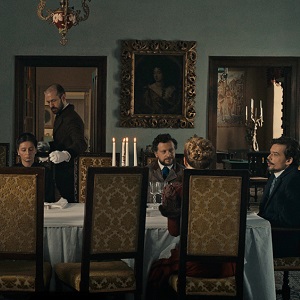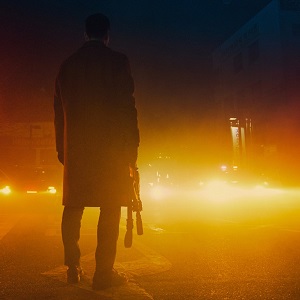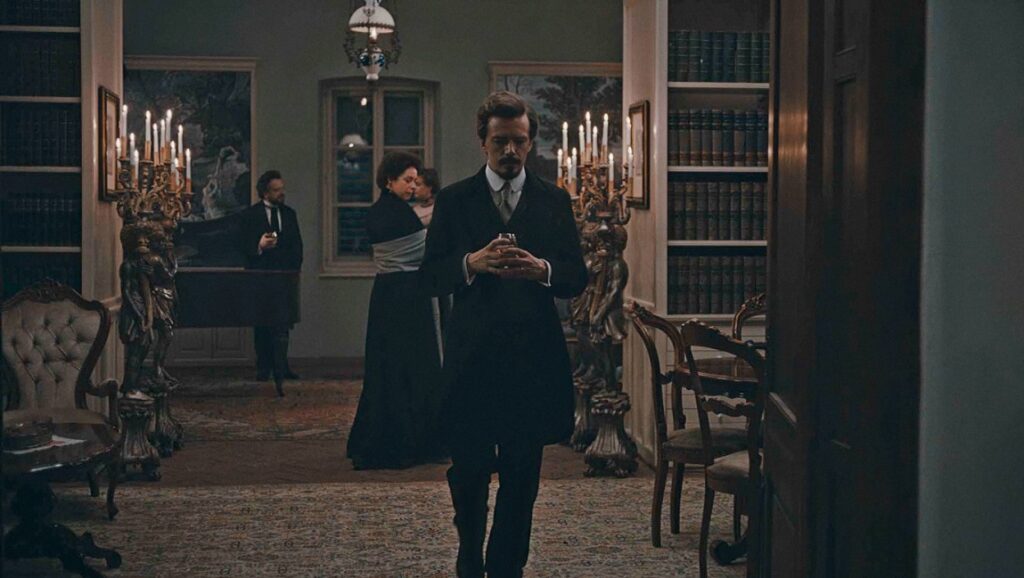Our fourth (and tentatively final) dispatch from the 2020 Berlinale catches up with a pair of the festival’s biggest premieres (Cristi Puiu’s Malmkrog and Tsai Ming-ling’s Days) as well as a couple docs (The House of Love and Little Girl); it offers thoughts on decade-later sophomore effort from Yoon Sung-hyun (Time to Hunt); and it has our take on the festival’s Best Debut Feature-winning Los Conductos. Because we at InRO are notoriously fickle, there is a slim chance we may improvise yet another dispatch next week, depending on our energy levels. But if not, watch for some words on films not covered in these dispatches throughout the spring — and look for more March festival coverage as well.

But unlike Sieranevada, which breathes with rich, contemporary social detail despite its claustrophobic two-room setting, Malmkrog is mostly restricted to abstractions and theories. To be fair, that’s part of Puiu’s design: the film was born from the work of Russian thinker and spiritualist Vladimir Solovyov, whose writings also inspired Three Interpretation Exercises, and whose philosophical preoccupations set the agenda for a group of six aristocrats trapped together in a snow-bound manor house around the dawn of the 20th century. Naturally, they have nothing better to do than argue the finer points of Christ’s resurrection and the nature of evil. Because Puiu stages their stuffy, interminable debates within an opulent period frame (and tosses in a few surrealist gestures for good measure), he asserts — in the widely recognized language of the festival economy — that Malmkrog is not simply another talky exercise, but rather a fully fledged, fully cinematic work.
It’s a problem, then, that Malmkrog’s dialogue elucidates precious little about time, place or character, and doubly so that it plays, finally, like another tired feat of performance art masochism. In fact, the film operates best whenever you give up on the subtitles and simply look around instead: Puiu’s compositional skills are—as ever—razor sharp, and he offhandedly details the background action of the servants with thrilling fastidiousness, proving that he ought to consider following in the footsteps of his fellow countrymen Corneliu Porumboiu and shift to making perfectly mediocre police procedurals. But if Puiu’s going to insist that his people keep on carrying on, he would do well to revisit M. Scherer’s old essay and heed the master’s words: “The director’s art is not to make us forget what characters say but, rather, to help us not miss a word.” If he doesn’t, he will continue to mistake mere prattle for talking cinema praxis. Evan Morgan

Tsai’s two leads, mainstay Lee Kang-Sheng and newcomer Anong Houngheuangsy, in his debut, drift through different worlds before converging in a hotel room for two extended scenes of unflinching, almost unbearable tenderness. Their solitude suffuses nearly every shot, from Anong squatting in a dingy apartment washing vegetables to Lee standing at the foot of a tree massaging his neck. Tsai frequently shows his characters in positions of vulnerability, either praying, showering, or sleeping, and their passivity highlights the tactile sensuality of the world around them. This world is, for the most part, closed off to them — by choice or otherwise — yet their moments together breach the circle each has drawn around himself. For a while, they allow themselves to share the same space, breathe the same air, reach out and touch something soft and unfamiliar. While Taiwanese new wave cinema has many torchbearers, few are as inaccessible as Tsai. In the wake of his glacial pacing, it’s understandable that viewers feel compelled to imbue the simplest gestures with outsize significance. But life isn’t like that; life is a steady build of routine, a series of rhythms so familiar they verge on oppressive. As Tsai notes, “in life, there are not that many things to talk about.” We pass the same buildings each day and sleep in the same bed each night. Sometimes we’re with others, sometimes we’re alone. Tsai’s characters, and his viewers, seek solace in the unexpected, occasionally sublime textures of these routines rather than their unremarkable action: a perfect square of light in a dark hallway, the outline of a cat behind a bank of dirty windows, or the twinkle of a music box against passing traffic. Selina Lee

The basic grammar of the film’s genre influences are recognizable throughout and are well-served by the first act’s world-building, which effectively makes plain the country’s dire economic situation. However, as the film gets deeper into its 135-minute long runtime, it soon becomes obvious that it has not been developed to meaningfully engage the more granular details of the economic scarcity and precarity it references, nor to even utilize the genres it references to expand on these matters indirectly, but rather more to have each become contexts through which it can return to its saccharine dramaturgy and reiterate the importance of dreams and brotherhood. It all adds up to a film that is as hopelessly out of its depth as its characters, lacking the creativity to mimic the ambitions its artistic coordinates should inspire — a problem as evident in the film’s numerous lethargic setpieces as it is in the half-baked nature of the project as such. Owing to all this, Time to Hunt is more mediocre pastiche of all things current in blockbuster cinema than a genre picture in its own right, which at worst may signal that corporate Hollywood’s banalization of the industry has gone global; but more likely indicates that if a work this bloated, confused, and unimaginative — that even hints at a sequel, retroactively casting itself as a kind of superhero origin story — is the best Yoon Sung-hyun can do after ten years away from the industry, it might be best he take even more time out. Matt McCracken


As curious as Bianca’s clients may be, Ferri has no interest in turning the film into a freak show or simply luxuriating in the grotesque. Bianca is certainly non-traditional, using ‘she’ as her preferred pronoun, but also sporting a fully shaved head and comfortable with either male or female clients. Ultimately, the power of the film comes in the presentation of its content as perfectly natural. Ferri shoots each encounter with a client in a different fashion — one scene is a static master shot, another featuring a slowly panning camera that passes back and forth between Bianca and the client, and yet another is all expressionistic close-ups, turning a sexual act into an abstracted collision of writhing bodies. Ferri seems to be suggesting that each session is its own narrative, that every interaction is both unique and part of Bianca’s larger story. The film is not overtly political in any didactic sense, although in our present making a documentary about a trans sex worker is of course deeply political. It’s a kind of radical empathy, a powerful reminder that sex work is work and trans rights are human rights. Daniel Gorman

For most of its runtime, the film pushes Sasha aside and out of focus, and instead inundates itself with parental interviews — specifically, with the mother — or merely spends time accompanying the family into clinical psychiatry sessions. Lifshitz remains too straightforward, his bland, emotion-forward approach leaves little ambiguity to interrogate — the overuse of close-ups provides even visual evidence of this failure. It is understandable that Lifshitz intends his camera to remain close to his human subjects, but it deprives the audience from the context of observation, bearing little witness to Sasha’s life in broader focus. Not all such moments are absent in the film — the ballet classroom scene, some interludes of domesticity, and one at the beach are a few affecting inclusions. But the final (more or less cliché) scene of the film shows lovely little Sasha dancing alone and silently, dressed as a girl with two fake pink butterfly wings tied to her back. This image also proves a fitting metaphor for Lifshitz’s effort: a film that tries to fly but which remains firmly planted to the ground. Ayeen Forootan


Comments are closed.